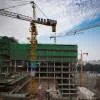The National Bank for Financing Infrastructure and Development (NaBFID) has set a target to sanction Rs.3 tn by March 2026, as announced by Union Minister of Finance Nirmala Sitharaman. Rajkiran Rai G, Managing Director, elaborates upon the bank’s policies and processes, evaluation mechanisms, plans for long-term financing, and more. Excerpts:
To date, NaBFID has sanctioned over Rs.1 trillion with projects across the country and in subsectors like roads, renewable power, ports, railways and city gas distribution. Which other sectors have been selected for disbursal?
Other than roads and transportation, conventional power and renewable energy, we have sanctioned and disbursed, or are in the process of disbursal, in sectors like data centres, warehousing, education, water, industrial parks, hospitals, electricity transmission and sports infrastructure.
As government intervention is dominant in infrastructure projects, how does NaBFID evaluate proposals and monitor the progress of crucial, big-ticket projects?
Our evaluation process is quite rigorous and detail-oriented with exhaustive checks and balances built into the process. Our in-house credit policy and rating framework is based on prevailing regulatory, market and operational risk parameters. All proposals go through independent evaluation by the credit risk, compliance and legal departments before sanction and disbursal. All big-ticket proposals are evaluated and cleared by the executive committee where external members, including the external board of directors, deliberate and decide. The credit monitoring team has been strengthened in the past two years; it periodically reviews various project parameters and reports internally at various levels. Further, our concurrent and internal audit mechanism is in place, which helps us flag deviations and remedial actions, if any. The industry research team works on various developments in the sector. We have hired specialist talent for these functions from the market.
Also, what evaluation mechanisms are in place to assess the impact of infrastructure projects?
A significant percentage (~27 per cent) of our sanction is towards renewable energy projects, which have no or minimal impact on the environment. In all sanctioning cases, we carry out an assessment based on Think Hazard tools (a globally accepted tool that helps project planners identify natural hazards in their project
area and understand how to reduce their impact). Besides, the loan proposals’ due diligence weighs
in their environmental and social impact.
NaBFID is in the process of developing an impact assessment framework to measure external impacts (both positive and negative) of projects funded by us. Under this framework, NaBFID shall measure and value the social, economic and environmental impacts of existing and future projects. The assessment will lead to informed decision-making by stakeholders through a better understanding of potential impacts. Further, it shall assist in attracting investors by showcasing transparency and alignment with ESG goals.
Will NaBFID be able to undertake long-term financing of 20-25 years with takeout financing?
We are already doing long-term financing ranging from 20 to 25 years. Our ability to raise long-term resources makes us best positioned to undertake long-term financing. There is a need, though, to develop risk mitigants in the form of instruments (long-term swaps) as well as a new approach towards borrowing, say in fixed rates, as that obviates the need for us to hedge interest rate risks given that our resources are fixed cost in nature.
India has had an unhappy experience with infrastructure financing institutions. So, can one hope that with NaBFID, India has finally cracked infra financing?
The earlier DFIs had challenges in terms of restricted scope of lending and raising liabilities without government support and regulatory enablers like statutory liquidity ratio (SLR) eligibility of bonds. It made them uncompetitive in the lending market. It restricted their scale-up while exposing them to concentration risks. NaBFID is a culmination of systemic learning and takes a holistic approach towards infrastructure. It has both developmental and financial objectives focused on creating impact investment.
NaBFID offers a distinct advantage to borrowers with longer tenor loans, say 15 to 25 years, longer reset on loans, say three to five years, as also fixed interest rate loans up to 15-25 years, making infrastructure developers better positioned to navigate the interest rate cycle and manage risks. It also envisions bringing in innovative financing solutions through equity contribution in projects, credit enhancements and guarantees, securitisation of assets, etc. Being a sovereign-promoted, well-capitalised, AAA-rated entity, NaBFID is able to raise resources
at very competitive rates, with costs almost similar to state governments. Besides, the Government has enabled NaBFID through grants, sovereign guarantees at minimal cost and hedging cost reimbursement on a case-to-case basis. It also enjoys tax exemption for 10 years.
We are not following a preset template but focusing on bringing efficiencies via innovation and consistent follow-ups to enable productivity gains and minimise uncertainties.
In less than a year of operations, NaBFID disbursed about Rs.150 bn. However, it has been mandated with deepening India’s infrastructure investment pipeline. Given that the Government has to keep its deficit in check and yet continue public spending to keep the GDP in high gear, how does NaBFID plan to raise resources to fulfil infra-financing needs?
To date, we have raised resources through various sources such as long-term bonds and long-term loans from banks. Moving ahead, NaBFID is also planning to tap the foreign currency-dominated bond market/ECB. We are in an advanced stage of getting a global rating for such issuances. Further, we have already conducted a non-deal road show towards our foreign currency borrowings with various bond investors and foreign banks in the UK. Also, NaBFID is in touch with the Asian Development Bank, World Bank, Japan International Cooperation Agency and Asian Infrastructure Investment Bank to explore the possibility of blended finance or green finance.
NaBFID's debut bond issue was oversubscribed nearly fivefold (4.7 times) – the largest debt issuance by an All India Financial Institution (AIFI). Given the upgradation of Indian bonds with JP Morgan and Bloomberg indices, do you foresee the bond market finally coming of age? Has NaBFID formulated any other innovative financing structures?
Since the 2023 announcement of India’s inclusion in major emerging market indexes, Indian government bonds have attracted sizable FPI inflows of $ 18 bn and are set to continue as India’s index weight increases. Although volumes in the corporate bond market have increased multi-fold in the past few years, it still lacks market depth in terms of dominance of higher-rated issuances, limited investor base and low secondary market trading volumes. NaBFID has done a lot of groundwork to deal with some of these issues. We have conducted multiple discussions with all stakeholders including issuers, investors, arrangers and market makers for the creation of an enabling ecosystem. To help lower-rated issuances and raise capital, NaBFID would be rolling out a product of partial credit enhancement for bonds, which is currently under discussion. Once introduced, this will allow issuers with lower ratings to access the bond markets on the back of higher ratings with credit enhancement from NaBFID.
NaBFID is also working on facilitating urban local bodies to access capital and financial markets for investment in critical municipal infrastructure through pooled financing bonds on behalf of one or more identified ULBs for investment in identified urban infrastructure projects. Other innovative financing mechanisms like concessional finance in collaboration with MDBs, blended finance structures and CDS (credit default swaps) are being explored.
What policies does NaBFID have in place to address environmental and social considerations?
NaBFID has a board-approved environment and social (E&S) policy that sets out its commitment to environmental and social risk management across the project lifecycle. The E&S policy enables NaBFID to proactively manage the impact of projects and promote sustainable economic development. NaBFID has also put in place an environment and social management system (ESMS). This lays the framework for the integration of E&S risk assessment in the overall credit evaluation process. ESMS covers detailed guidelines for project screening, E&S risk categorisation, detailed diligence, integration of E&S covenants in the term sheet and project monitoring. A dedicated E&S team at NaBFID is being set up to ensure adherence to the E&S policy.
Apart from lending, as it is also looking at project advisory roles in railways and transportation projects that are stuck or have not moved at the required pace, what other factors make NaBFID different?
NaBFID has come up with several innovative initiatives to create an ecosystem for infrastructure financing as evidenced by the following:
Partial credit enhancement
to expand the issuer base
while enabling domestic institutional investors to subscribe to the offerings
Transaction advisory services to develop a project pipeline
Partnership with multilateral development banks (MDBs) for product innovation, blended finance, capacity building, and access to low-cost resources
Data repository for the infrastructure sector in collaboration with PM Gati Shakti to crowd in private capital
Positioning itself as a vehicle for green financing.
In NaBFID's first-ever offering, investors did not have to worry about investment limits, triggering a gold rush. What measures have been taken to ensure that demand sustains and future debt sales of NaBFID continue to entice strong investor demand?
NaBFID has raised Rs.284.27 bn so far through four tranches of bond issuances. In terms of sources of resource raising, NaBFID has relied partly on long-term loans from banks and partly on long-term bond issuances. The onus on any one avenue is relatively limited. Additionally, our issues have enjoyed a diversified investor base with ample headroom available for individual investors to meet our needs. Last, there is a lot of unmet demand for long-term assets. Recent market trends suggest that AUM of insurance, EPFO and pension funds (Rs.117 tn) are growing at an average CAGR of 14.12 per cent compared to bank deposits (`230 tn) of 9.68 per cent. These funds are on the lookout for assets that are long-term in nature. Deployment of these pools of capital in consonance with the points mentioned above will help sustain strong investor demand.





















